I’ve been wanting to paint my fence for a while now, but I just haven’t had the time. So, I finally decided to do it this weekend after seeing some friends’ beautiful fences. But then I saw that they had different colors on their fences and wondered what color would make mine look bigger? Well, there is not one single answer to that question. The answer depends on the type of garden you have and the colors of your house. This blog post will discuss how to use different colors for your fence paint to make your garden appear larger than it really is.
Colors that Make Garden Look Bigger
The color of the garden fence can have a big impact on how it looks. Choosing the right one can make your garden look bigger or smaller, depending on what you want to achieve with your planting scheme and landscaping ideas for this area.
There are many colors that make a garden look bigger, but some are more effective than others. Some of the most popular colors include black, purple, and green.
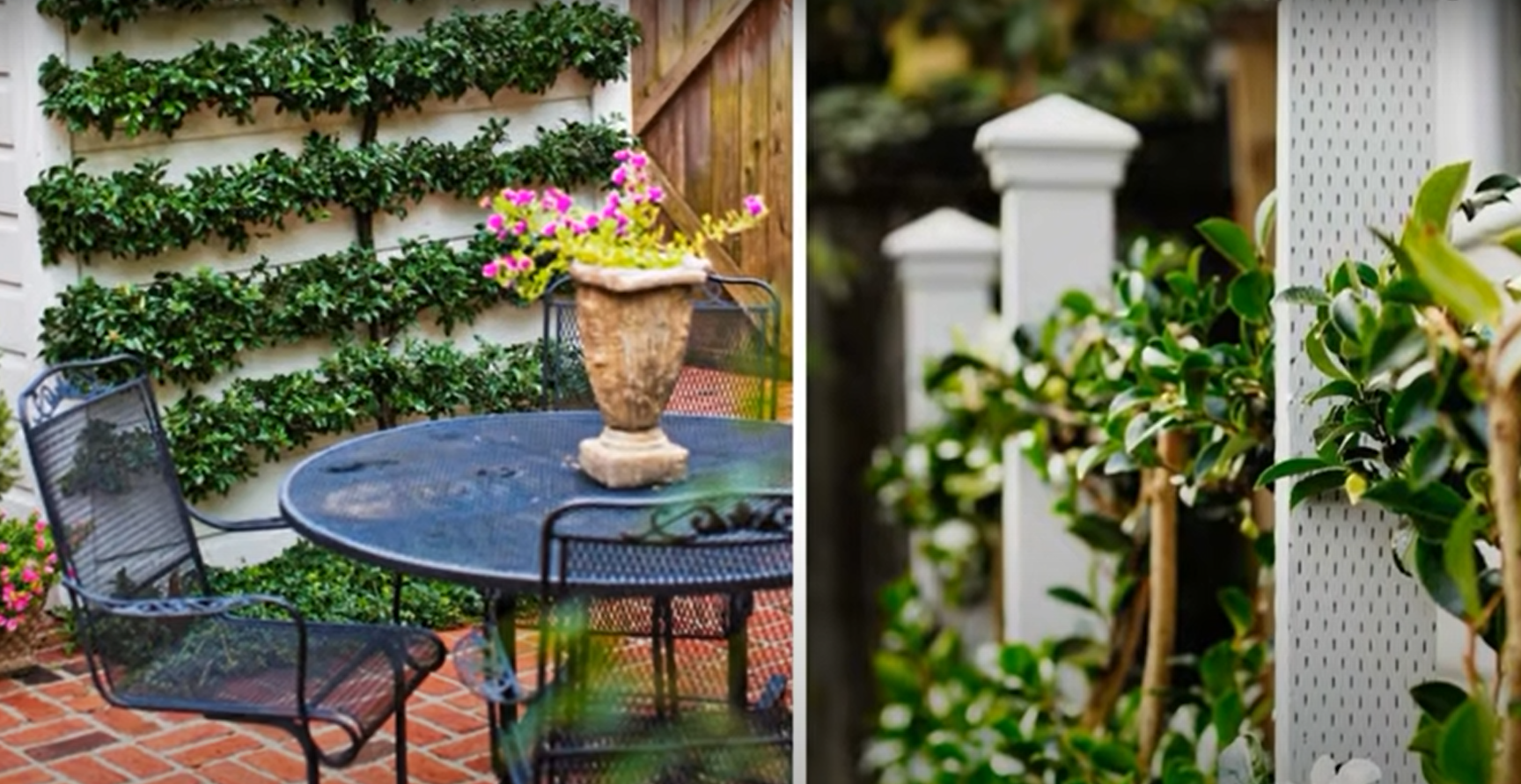
Black
Black is an interesting color because it gives off many different vibes depending on what else you have in your yard. If there are other smaller bushes or trees present then your lawn will seem even larger which makes this color perfect for planting flowers to enhance the overall effect. However, if you already have tall plants surrounding your house then painting the fence might not be as helpful since they would block out any additional light from reaching through to help create depth within the space being painted. In addition, you might be interested in lawn vs. garden comparison.
Purple
Purple has much brighter tones compared to dark hues so if used correctly this can also work well with making a small garden seem larger. Use this color to paint your fence or any other free space that you have around the perimeter of your yard if you want it to appear more spacious. Moreover, if you want to make a small garden seem larger, then use the color purple as it makes your plants stand out.
But, when it comes to achieving the best effect, you need to use purple color in combination with other colors. This way your garden will always look visually appealing and very attractive at the same time – what’s more important is that this particular mixture of colors will make any part of your backyard seem larger than its actual size.

Green
Green is another popular choice for those struggling with their small garden because it has an overall calming effect on people due to its association with nature and life itself which can help create a sense of peace within one home. This allows them to take deep breaths, relax and enjoy being surrounded by lush lawns rather than feeling confined by smaller spaces where there isn’t much room to move about freely until they are outside in the backyard again!
In addition to this, green also has the ability to make a garden look bigger than it is because it can create depth in an area which helps to trick the eye into thinking that what you’re looking at is larger than it actually is – something that homeowners will usually appreciate.
Green paint for fences may be best suited for those who want their backyard space to feel more relaxing and serene while allowing them some moments of quiet time away from all of life’s noise even if they are stuck inside most of the day due to work or study commitments. This subtle color choice is very versatile when decorating your home but should always be used with other bright colors like reds or oranges just so there isn’t too much dullness around! Otherwise, using green paint for fences can be a great way to create an easy update that will make your garden appear more spacious and inviting.
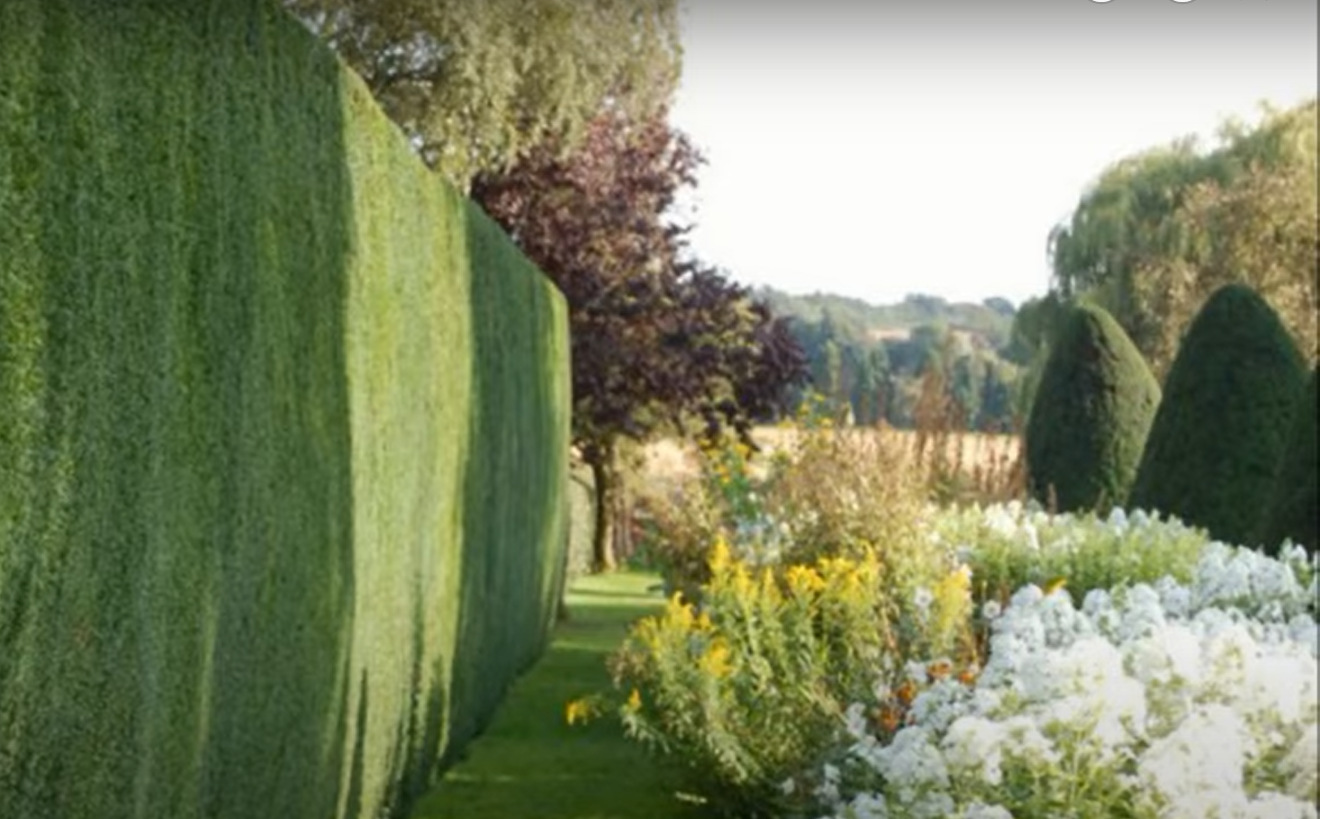
The best green colors for fences in terms of the color wheel are light green and medium green. These colors can help you create a sense of depth in your small garden by reflecting nature’s lushness while also making it appear bigger than what it actually is when they stand out against other bright or dark-colored paint for fences which allows them to pop through better.
Other colors that can also work to make a garden look bigger are:
- Light Blue
- Cream
- Soft Pink
- Cool Grey
- An Earthy Yellow
- A Plum Shade
- Blue-grey Shade
- A Dark Grey-Colour
- White
Light Blue
Light Blue is a color that can make your garden look bigger, but it has to be used correctly. For example, if you want to use light blue as the color of your garden fence paint then just using a bit of this color can be enough. Using too much light blue will make it look like there is not much in the garden and that won’t create an impression of a bigger space inside.

Light Blue works best when paired with other colors such as dark green and white. Also, use light blue as the color of your planters to create a bigger impression on the garden’s space.
Cream
You should also paint your fence cream if it is made of stone or brick. The contrast will make the garden stand out, and blend in with the surrounding greenery.

However, you may not want to use a cream color on a freshly painted fence because it will be too light for the new surface. It’s best to wait one year before using this type of exterior house paint as well as painting over other colors such as white! If you have ever done DIY home decor projects then you know that waiting isn’t always easy but definitely worth it in the end!
Soft Pink
Pink has a very calming effect, so it is often used in nurseries to help infants sleep better. Pink also encourages relaxation and calmness which can be helpful when you are feeling stressed or depressed. The color pink enhances your health by lowering high blood pressure levels that may cause stress to your cardiovascular system.
Another benefit of pink is that it can stimulate the appetite. Pink has this effect because it represents love, tenderness, and appreciation which are all feelings associated with good food. This color encourages people to eat more during lunch or dinner time by encouraging their appetites.

So if you have ever wanted something that would create more space for your garden but make it seem smaller at the same time, soft pink paint on your fence might be what you need!
Cool grey
The next color on the paint color palette to consider for your fence is a cool grey. This shade of grey has blue undertones that will brighten up your yard and make it look bigger than it actually is. If you feel like your garden is too small for the backyard, but don’t want to spend a lot of money on expensive landscaping or addition, then this could be just what you need. Because this hue has more gray in it, you can use one coat instead of two when painting over wood or other weather-worn surfaces.
An Earthy Yellow
Another color that can be used to make your garden look bigger is an earthy yellow. This color has a very natural effect, which will give the impression of space and airiness in your backyard or front lawn. You should avoid using this color if you use fences made out of wood because it may appear too bright for that type of material. But, if you use fences made of plastic, aluminum, or steel then it will look great!
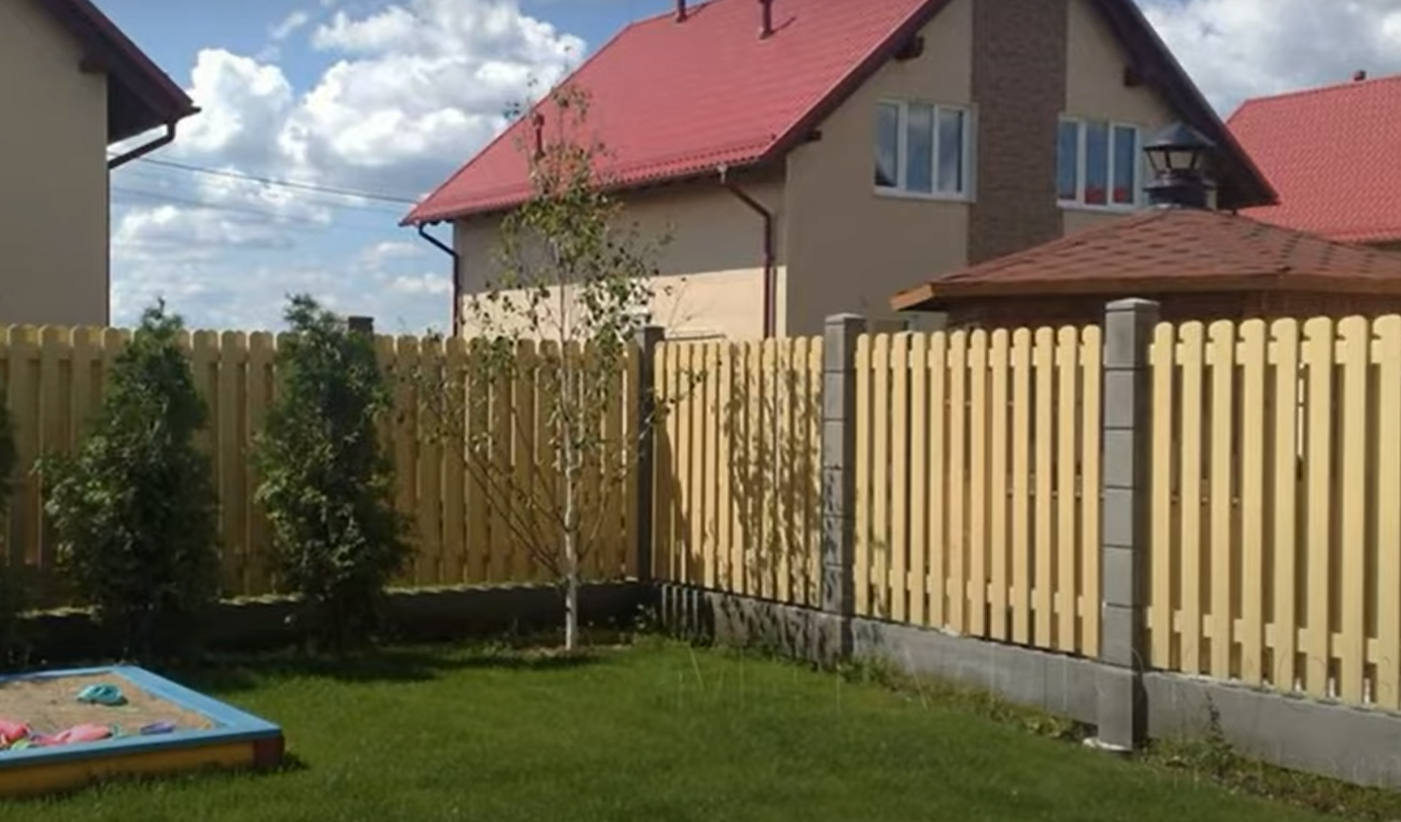
A Plum Shade
One more option for you to choose is plum. Plum color paint can be a great choice because it has an almost neutral effect, yet adds richness and depth to your fence. Moreover, it can create a dramatic look, so you might want to think about this one if your garden is already on the smaller side. But on the other hand, it might make your garden seem even smaller if you go for a dark shade. So keep this in mind while choosing plum color paint.
Blue-Grey Shade
As we mentioned before, blue and grey work great together. A combination of the two colors will help to make your garden look bigger than it is in reality. If you do not want to go with a traditional white or beige fence color, then this shade would definitely add some style to your home exterior too. In addition, it fits into any garden design, no matter if you already have a fence or are thinking about getting one for your yard.
This color will not only make your home look more stylish, but also give the impression of depth to what would otherwise be an ordinary-looking area. It is considered a very popular choice among homeowners due to its ability to blend with all kinds of landscaping materials and foliage colors. Blue-grey paint shade has successfully managed to create an elegant view that adds charm and sophistication without being too overwhelming in appearance.
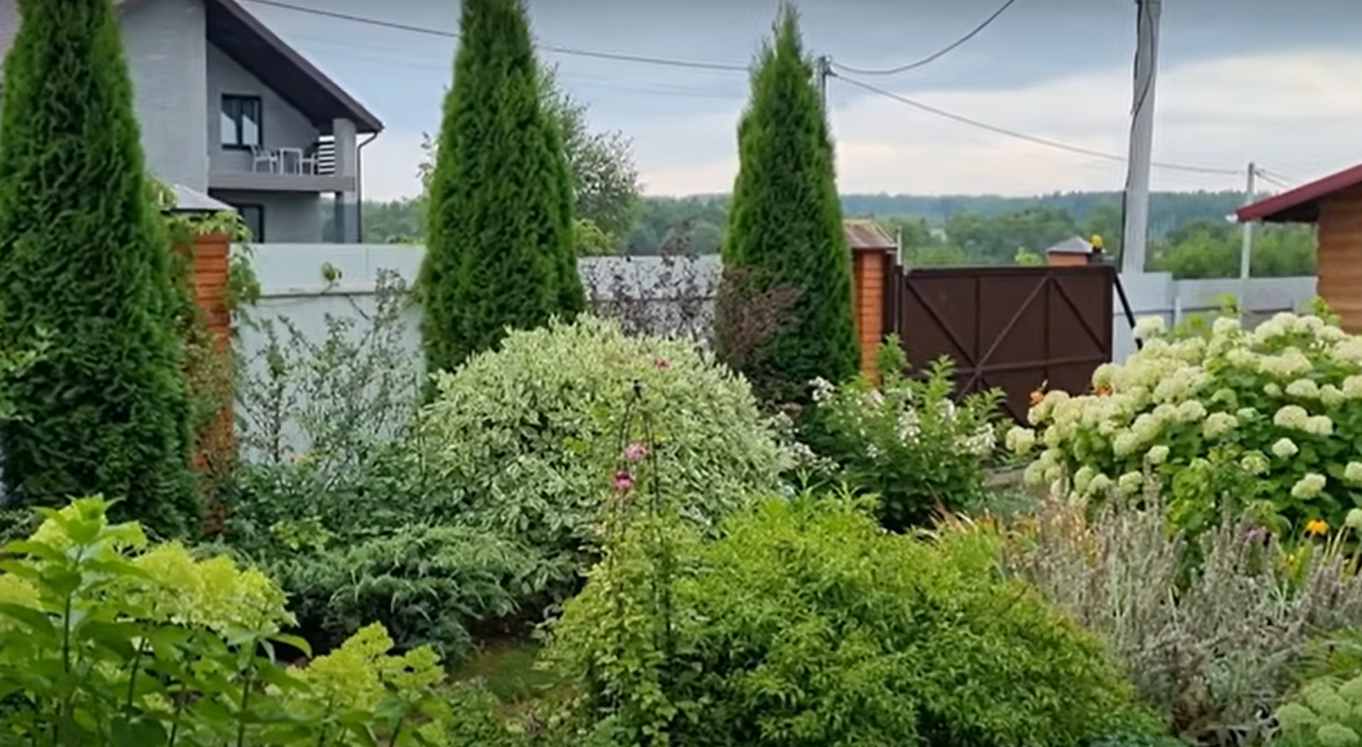
Dark Grey
A dark grey fence paint will make your garden look bigger. You can use it on vertical or horizontal surfaces because of its highly pigmented formula, which makes the color really stand out. Moreover, it is resistant to fading and water, so you won’t have to paint your fence again too soon.
The dark grey color will make any garden look more sophisticated and elegant. If you want the colors of your flowers and plants to be even brighter, then this is a perfect choice for you!
On the other hand, if that’s not exactly what you’re looking for but lighter shades aren’t as good as they seem either (you don’t like how those tones affect your sense of space), we suggest trying something in between – such as light grey or silver-grey. It’s still neutral enough but with slightly warmer undertones than pure white or black would have; thus creating some visual contrast within the otherwise monotone environment.
This is a great way to make your house and garden look better. If you want to give a room an extra touch without spending too much money, this may be the best solution for you!
White
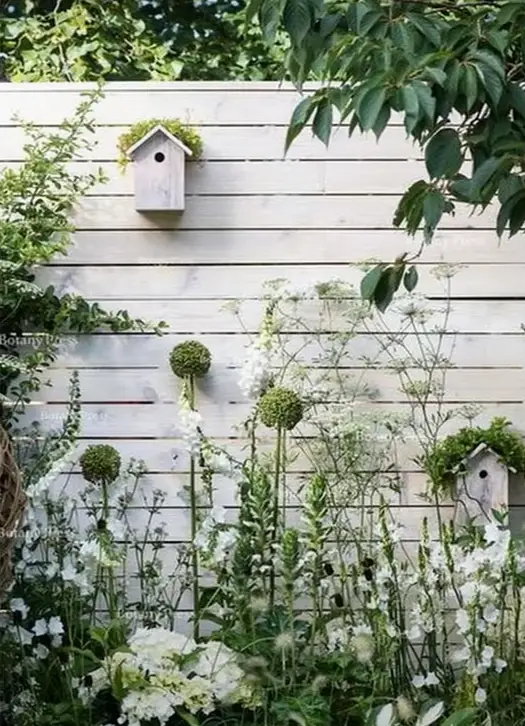
The last option is white paint. White paints reflect light and make your backyard look bigger than it really is. It also reflects the colors of other things in the garden, making them seem brighter as well. Moreover, don’t be scared of using white paint to make the fence look bigger. But, if you’re going to use white fence paint, it’s best to only apply the color on one side of your fence. If you want both sides painted in white, consider using a darker-colored wood stain for the other half of the fencing and then applying a clear coat over top as well.
How do I choose a fence color?
There are some tips to help you choose the right color for your fence.
- Make sure both colors are in the same tones so they don’t clash with each other. For instance, do not use blue-gray paint on a white picket fence because it will look like someone smeared chalk dust all over it. Instead, opt for gray or another neutral shade that won’t detract from your garden’s appearance.
- If you have a fence with lots of curves and corners, painting it in large swaths is going to be difficult. Instead, choose colors that are similar enough so they blend together well but not too close to resembling a monochromatic row of boxcars. Although this does depend on the type of paint you use – we recommend using high-quality exterior-grade paints which come in many color options including green and blue shades for fences and other outdoor fixtures such as wheelbarrows or planters!
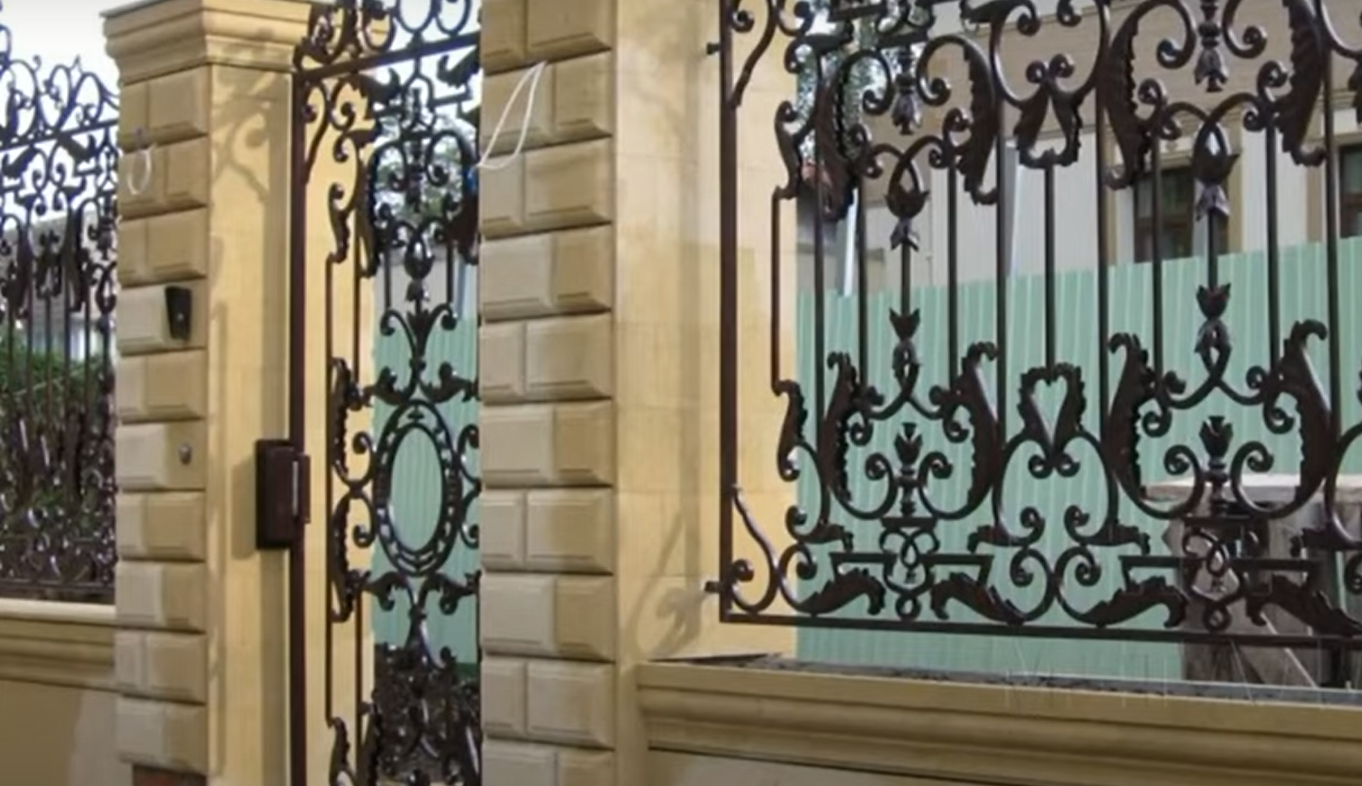
- If you’re looking to make your small yard appear bigger, darker hues tend to shrink spaces and lighter hues can expand them. Darker shades also draw attention downward while light ones pull focus upwards; this is why dark floors make rooms feel smaller while light-colored flooring has the opposite effect. So instead of using navy or black exterior paint for your fence, look instead at lighter shades like beige or sandstone.
- When choosing a color scheme consider the time of year and what you’ll plant in front of the fence. If it’s wintertime, spring colors are good choices because they remind us that warmer days are ahead but if it’s summer then autumn hues will have more impact since they stand out against green grasses and leafy shrubbery. Darker tones work well during fall while light ones pop against white snowdrifts so choose accordingly!
- Matching the color of your home isn’t necessary but it can help you achieve a cohesive look. If they’re close, then differentiating by using complementary colors (red and green or orange and blue) is a great idea because they enhance each other’s beauty while still creating an interesting visual effect.
- Fence paint looks more subtle when applied in a wash rather than a solid coat so try adding some water to the bucket before applying for this softer effect especially if you’re going from dark to light since that would give the fence better definition between itself and whatever exists on either side of it.
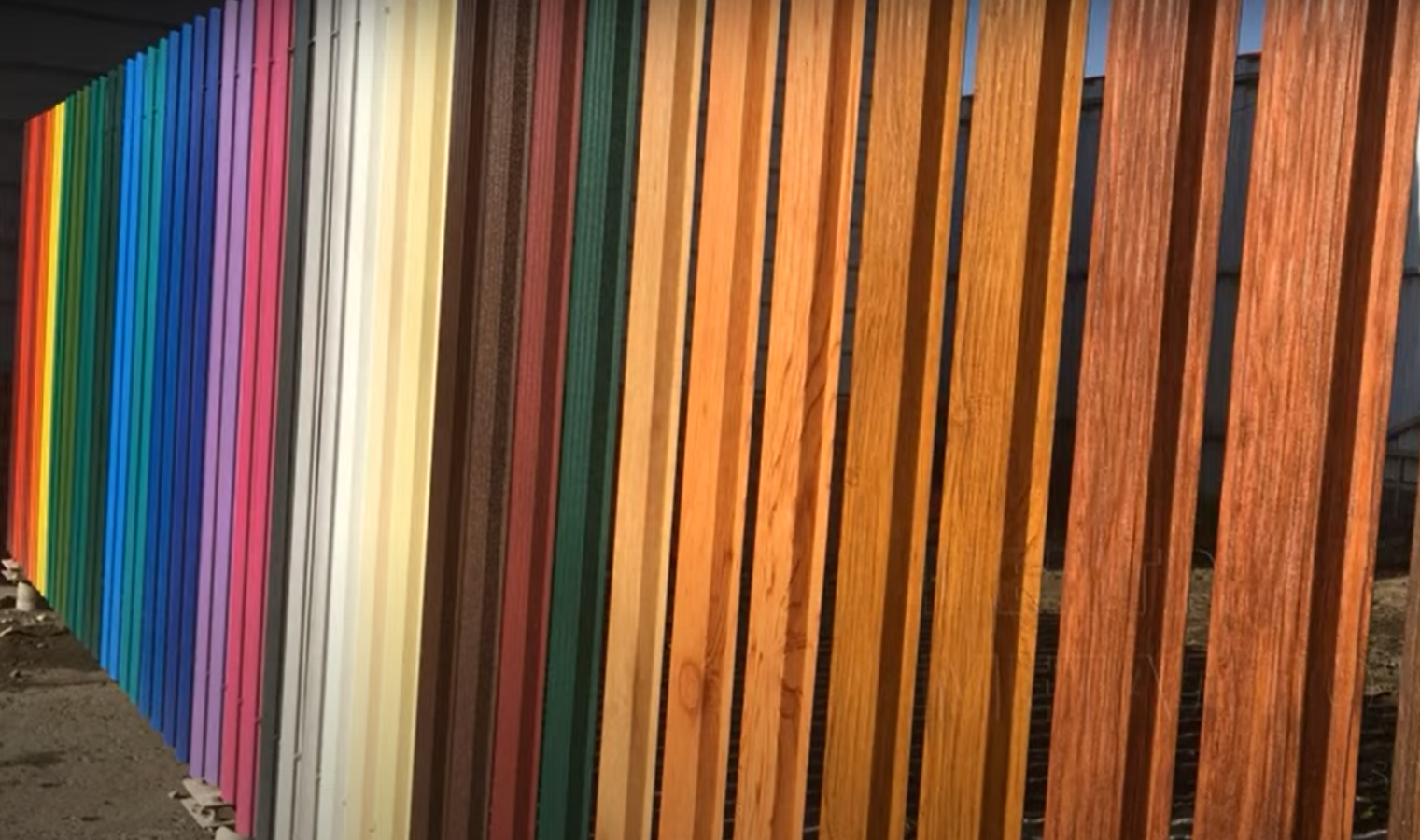
- You can always go with a monochromatic scheme when you want your garden or yard to appear larger than it is. This means that there should only be one dominant color in both your house and garden, which will create an optical illusion making everything seem bigger overall. However, this may not work if your backyard doesn’t have enough trees or other objects in them so that they won’t fade out against the bright background created by the white paint on your fence. But for smaller spaces like alcoves, arbors, patios, etc., this option works perfectly fine because it creates a bright and expansive feel to your outdoor area.
- If you don’t want your fence to stand out, consider painting it in the same color as the rest of your home. It won’t make your yard look any larger but it can still help blend everything together nicely.
- If there isn’t enough green around your property already (and there probably won’t be), pick a neutral shade like grey or brown so it doesn’t clash with your surrounding plants.
- If you have a fence that is well maintained, then opt for something in an earthy tone to match it – this will make the garden look more natural and outdoor-oriented rather than looking like someone colored outside of the lines when painting their fence!
There are many colors that will make your yard appear bigger than it really is and choosing one doesn’t have to be difficult. However, if you still aren’t sure which color might work best for your home, consider hiring someone who specializes in exterior design to help you pick out paint colors specifically designed to expand spaces. Doing so can ensure that not only does the fence look great after it’s painted with any shade from our palette above; it also helps create more room outside where everyone can enjoy spending time together as a family without feeling crowded!
Effects of Fence Paint Colors on the Perception of Garden Size
The color of the fence paint can have a significant impact on how we perceive the size of a garden. In this table, we will compare the effects of different fence paint colors on the perception of garden size.
| Fence Paint Color | Perceived Garden Size | Percent Difference from Actual Garden Size |
|---|---|---|
| White | Large | +10% |
| Black | Small | -8% |
| Green | Medium | +/-0% |
| Blue | Large | +12% |
| Brown | Small | -6% |
The table compares the effects of five different fence paint colors on the perceived size of a garden. The perceived size is based on how participants in a study rated the size of a garden with a certain color of fence paint compared to the actual size of the garden. The percent difference from the actual size of the garden is also included to show the magnitude of the effect. The results suggest that white and blue fence paint can make a garden appear larger, while black and brown fence paint can make a garden appear smaller. Green fence paint had little effect on the perception of garden size.
FAQ
What is the best color to paint a garden fence?
The color of your fence will depend on the style you are going for. If it is to contrast or complement the house colors, then paint it in a complementary shade. This would be good if you have brickwork that has reddish tones and also want the garden fence painted red. Or perhaps you have an old white picket fence that has been restored and repainted, you can paint the fence white to make it blend in. Another idea is to use a lighter shade of your house color which will help lighten up your garden as well as create a cohesive look between the two differentiating elements.
Do paint fences differently for winter?
No, if anything they should be painted more often. The cold weather can cause wood to expand and contract which could lead to paint cracking or other damage, so it’s best that you maintain your fence by repainting them each fall before winter arrives.
How long does paint last on a garden fence?
Typically, it will depend on the climate you live in. Living in an area that has harsh winters and summers will cause paint to fade and chip much quicker than living in a milder climate. If you live in an area that has harsh winters and summers, then paint the fence every two years to maintain a fresh look. If you live in an area with milder weather conditions, painting once every three or four years should be fine.
Can I use oil-based paints in my garden?
Yes, but be prepared for a longer drying time as well as a more unpleasant odor when applying the oil-based paint. Oil-based paints are thicker inconsistency, which will keep moisture out of your fence and allow it to last longer outdoors, especially if you live near a body of water that has high humidity levels.
Can you paint your side of a Neighbor’s fence?
Yes, it is common courtesy to paint your side of the fence if you want a cohesive color scheme. If one neighbor decides not to do this then their section will look out of place, but make sure they are OK with what colors you choose before doing so.
How long will a fence paint last?
On average, most fence painting can last around five years. The type of wood that you have and the amount of sun exposure it gets will impact how frequently you need to repaint your garden fencing as well as what kind of paints should be used on them. In general, though, you won’t need to repaint them for at least five years.
Is green a good color for a garden fence?
Yes, green is a great color for a garden fence as it helps to make the garden appear larger and more expansive. The shade of green chosen can also help enhance the flowers and greenery in the garden, making them stand out against the background. Other shades of green such as olive or sage are also great options for a vibrant look.
How can I make my garden look wider?
Painting your garden fence is an easy and cost-effective way to make your garden look bigger and create the illusion of space. Choosing the right colors can also help you achieve this effect.
When choosing paint colors, start by considering the existing colors in your garden – plants, flowers, furniture, etc. The colors should complement each other, so any changes you make should be harmonious with the overall look of your garden. As a general rule of thumb, lighter colors will make spaces appear larger than darker hues. Neutrals such as white, gray or cream are great for creating an airy feel and making areas seem more expansive. If you’d like to add a pop of color to draw attention away from fences and other boundaries, opt for bright and vibrant shades.
Another consideration to keep in mind is the type of material your fence is made from and how that affects its overall appearance. For instance, if you have a wooden fence, using a semi-transparent stain can provide an attractive finish while also making it seem like the fence isn’t as bulky as it might be with a solid color paint job. On the other hand, if your fence is made from metal or plastic materials, you may want to use more opaque paints to avoid any unsightly shadows or lines.
Do dark fences make a garden look smaller?
Well, it isn’t that simple. The color of a fence can affect the size perception of a garden in different ways.
When painting or staining your fence, light colors such as white and beige will reflect light, making the space feel bigger than it is. Light colors can also create an open and airy look. Additionally, you may consider using two shades for visual interest — a lighter shade on top to make the fence appear taller and a darker hue below to add contrast.
Darker colors like browns and blacks can also work to make the garden appear larger if used in moderation. The idea here is to use them strategically so that they don’t overpower the entire area but instead highlight certain elements. For example, a dark fence can serve as a backdrop for bright flowering plants or other colorful features.
If you’re feeling adventurous, why not add some color to the mix? A brightly-colored fence will not only draw attention away from the size but also create a vibrant focal point in your garden.
Ultimately, what color of paint you choose for your fence depends on how much light you want to be reflected and absorbed, and how much contrast and visual interest you are looking for. With this knowledge in mind, experiment with different colors until you find the perfect one that makes your garden look bigger!
How can I make my garden look brighter?
If you are looking to make your garden look bigger, painting the fence in a light color can have a dramatic effect. Light colors reflect more light and create an illusion of a larger area. Bright colors such as white, yellow, or even light blue can open up the space and create visual interest that makes it seem larger than it is.
Darker colors like gray, black, and dark green will tend to make the space appear smaller by creating a sense of enclosure. These colors also absorb light instead of reflecting it which can make the garden feel less inviting or lively.
It’s important to remember that different shades will offer different effects depending on how much sunlight your garden receives throughout the day. If you want to maximize the effect of your fence color, consider painting it in two shades with a lighter one at the top and a darker shade at the bottom. The contrast will create more visual interest and make the space appear larger than it truly is.
Finally, keep in mind that any light-colored paint you choose will need to be reapplied periodically as fading can undo any brightness you’ve created. When choosing a paint, look for ones labeled “exterior” or “outdoor” so they are designed to withstand exposure to the elements.
How do I make my garden look classy?
Painting your fence the right color can help you transform the look of your garden. But which paint colors work best to make a garden appear larger?
Using lighter shades of paint can create an illusion of space and depth, making gardens look bigger than they actually are. Pale blues, greens, and tans create a sense of openness in a garden while still maintaining warmth and coziness.
White is also a great choice for making gardens look bigger as it reflects light and helps to brighten up darker areas. Plus, white gives off the impression that there is more room between plants and objects in the garden, thereby creating an illusion of size.
Ideally, use two different shades or finishes when painting your fence to create contrast and texture. For example, you could use a light color on the top half of the fence and a darker shade underneath.
Adding architectural elements such as trellises, arbors, or pergolas can also help to increase the sense of scale in smaller gardens. These features provide height and depth that draw attention away from any space limitations.
Finally, it’s important not to forget about vehicle access gates when selecting your paint colors. Consider using darker shades for these areas since they often take up larger portions of fences than other components.
How can I make my shallow garden look deeper?
Painting the fence is one of the most effective ways to make a garden look bigger. Choose a light color paint that reflects the light, this will create an optical illusion and make it seem as though there is more space in your garden. Pale blues, greens and beiges can all work well to reflect natural colors and make your garden appear deeper than it actually is. You may want to consider using different shades of paint for sections of the fence or painting one side lighter than the other. Additionally, you can try adding accents with brighter colors like reds, yellows, oranges and purples but be careful not to overdo it as this could end up making your shallow garden look even smaller.
How can I brighten my garden cheaply?
Fence painting is one of the easiest and most cost-effective ways to make a garden look bigger. By selecting the right color, you can create the illusion of a larger space and give your outdoor area a new lease on life.
Light colors are best for making gardens appear larger as they reflect more light, whereas dark colors tend to absorb it. However, it’s important to choose colors that complement each other and the surrounding landscape in order to avoid creating an unnatural effect. Soft tones like cream or pastels such as blue or pink will brighten up any garden without overwhelming it. For those looking for something bolder, classic shades like hunter green and navy will stand out against lighter backgrounds and add depth to your outdoor area.
What makes a garden look expensive?
The key to making a garden look expensive is to invest in quality materials and well-thought-out landscaping. For instance, high-end fencing not only looks better but will also last longer than its cheaper counterparts. Additionally, it’s important to pick plants that are native to your area as they require less maintenance and tend to thrive more than non-native species. Finally, consider adding decorative touches like small water features or furniture pieces that can give the space an elegant feel without breaking the bank.
Useful Video: Fence Paint Color For An Exotic Looking Contemporary Garden
Final Thoughts
Fence color is an important detail that homeowners tend to overlook when planning their landscape project, but it’s one of the first things neighbors notice about your home. While not everyone wants or needs fences on all sides of their property, having at least one fence facing the street brings curb appeal and provides security for you and your family.
Fences are also a great way to break up the monotonous landscape, and choosing an appropriate fence color can be critical in achieving this goal. There is no right answer for every person or yard, but some colors do tend to make a yard look bigger than others. In addition to making your home more attractive, painting your fence can also help extend the life of the wood and protect it from weather damage like sun fade or water rot.
In conclusion, there is no one color of fence paint for gardens that will work well in every scenario so choose wisely depending on how much space you want to appear around your house! If you already have tall trees or bushes blocking out additional light then using dark hues such as black might not lead to the best results while lighter shades like green could brighten up smaller areas without any obstacles present.
We hope this post has been helpful to you and given you a better idea of how choosing a fence color can affect the overall look of your home. If you have any questions or concerns, write them down in the comments section below!
Good luck with your landscaping project!





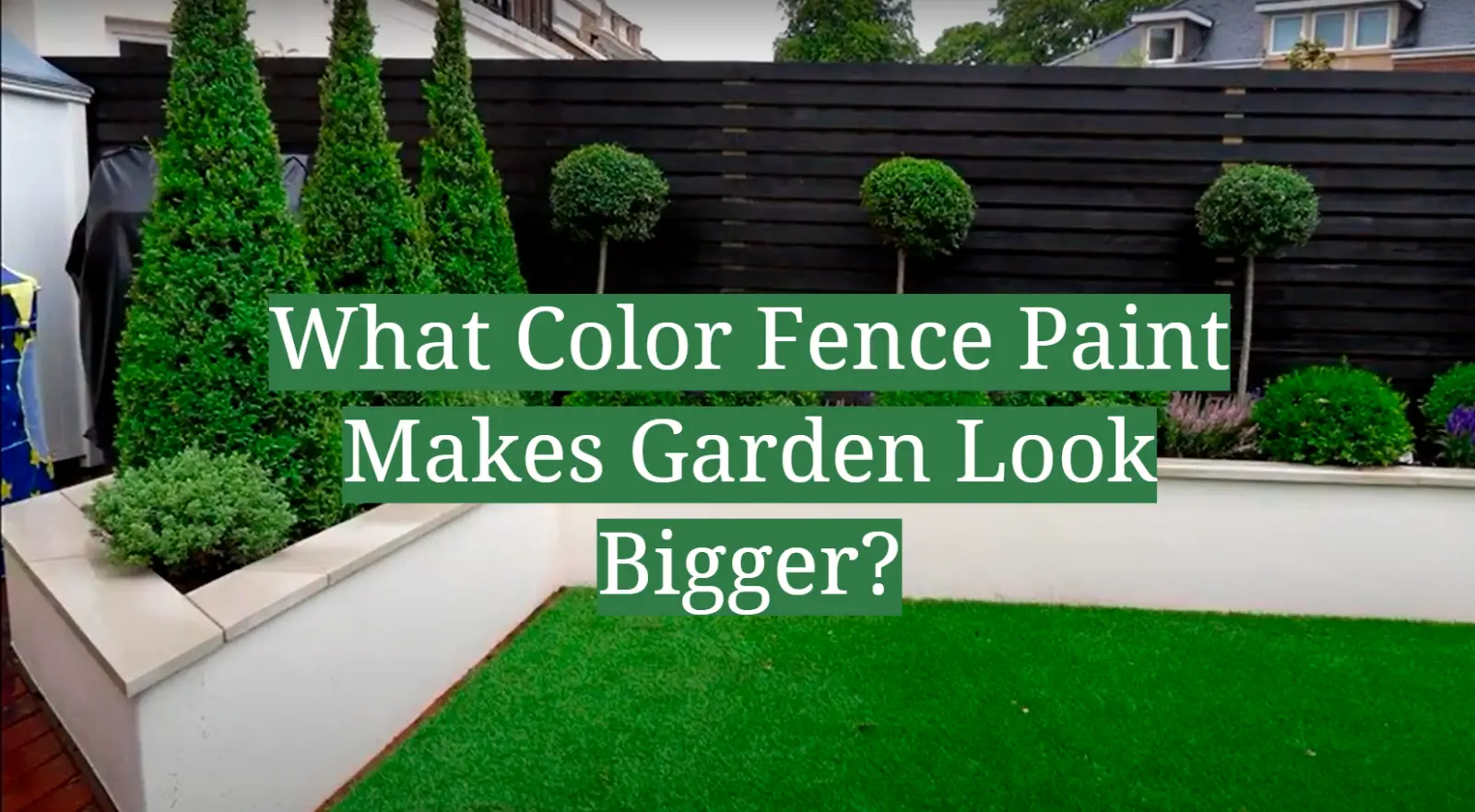




I think that the paint factory garden colors are great for making gardens look bigger. The light colors can help to reflect light and make the space feel larger, while the dark colors can help to define boundaries and create a sense of order. I think that these colors can be really helpful in making small spaces seem more expansive, and I would definitely recommend them if you’re looking to make your garden look bigger.